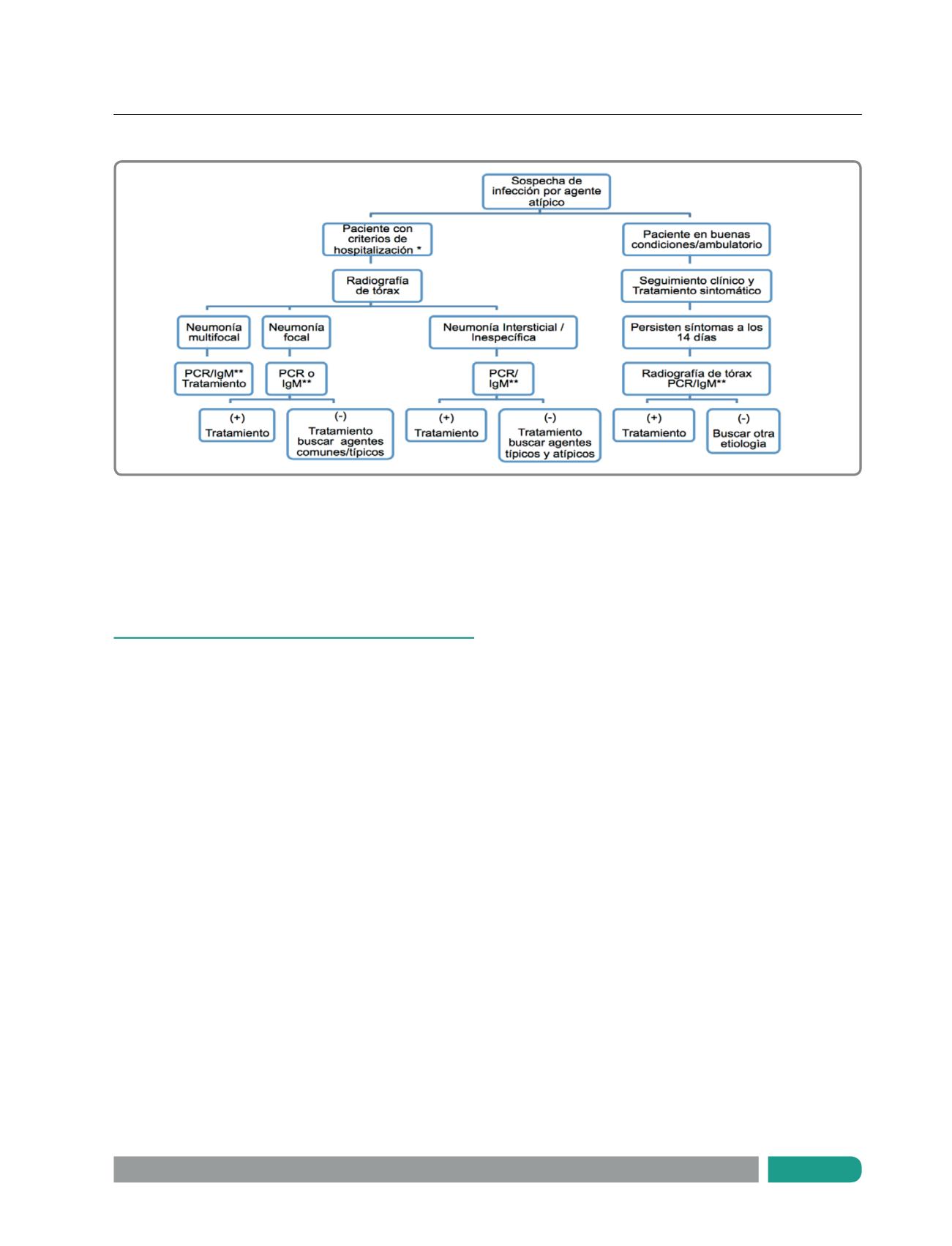

Neumol Pediatr 2015; 10 (3): 118 - 123
C o n t e n i d o d i s p o n i b l e e n h t t p : / / www. n e umo l o g i a - p e d i a t r i c a . cl
123
Neumonía por bacterias atípicas: mycoplasma y chlamydia pneumoniae
Figura 2.
Algoritmo de manejo clínico en pacientes con infección por agentes atípicos
* Criterios de hospitalización: dificultad o insuficiencia respiratoria, requerimientos de oxígeno, compromiso extrapulmonar importante,
sospecha de neumonía complicada o sepsis, neumonía , enfermedad subyacente
** Según disponibilidad
REFERENCIAS
1. Parra W. Neumonías atípicas. Neumol Pediatr 2013: 8:74-78
2. Murdoch D, Chambers S. Atypical pneumonia-time to breathe
new life into a unuseful term? Lancet Infect Dis 2009; 9: 512–19
3. Wolf J, Daley A. Microbiological aspects of bacterial
respiratory tract ilness in children: atypical patogens. Paediatr
Respir Rev2007;8: 212–220
4. Waites K. New concepts of Mycoplasma infection in children.
Pediatr Pulmonol 2003; 36:267–278
5. Baer G, Engelcke G, Abele-Horn M, Schaad U, Heininger U.
Role of Chlamydia pneumoniae and Mycoplasma pneumoniae
as causative agents of community acquired pneumonia in
hospitalised children and adolescents. Eur J Clin Microbiol Infect
Dis 2003 ;22:742-5
6. Prinipi N, Esposito S. Emerging role of Mycoplasma
pneumoniae and Chlamydia pneumoniae in paediatric respiratory
tract infections. Lancet Infect Dis 2001; 1: 334–44
7.Paul M, Vega-Briceño L, Potin M, Ferrés M, Pulgar D, García C.
Características clínicas de la enfermedad respiratoria causada
por Mycoplasma pneumoniae en niños hospitalizados. Rev Chil
Infect 2009; 26: 343-349
8.Wang K, Gill P, Perera R, Thomson A, Mant D, Harnden A.
Clinical symptoms and signs for the diagnosis of Mycoplasma
pneumoniae in children and adolescent with community
acquired pneumoniae. Cochrane Database Syst Rev 2012 Issue
10.CD009175
9. Vervloet L, Marguet C, Moreira P. Infection of Mycoplasma
pneumoniae and its importance as an etiological agent in
childhood community acquired pneumoniae. BJID 2007;11:507-
514
10. Candler P, Dale R. Three cases of central nervous syndromes
complications associated to Mycoplasma Pneumoniae. Pediatr
Neurol 2004;31:133-138
11. Cherry J. Anemia and mucocutaneos lesions due to
Mycoplasma pneumoniae infections. Clin Infect Dis 1993; 17
Suppl 1:S47
12. Loens K, Goossens H, Ieven M. Acute respiratory infection
due to Mycoplasma pneumoniae: current status of diagnostic
methods. Eur J Clin Microbiol Infect Dis 2010;29:1055–1069
13. Chang H, Chan L, Shao P, Lee P, Chen J, Lee C. Lu C. Huang
Li. Comparison of real-time polymerase chain reaction and
serological test for the confirmation of Mycoplasma penumoniae
infection in children with clinical diagnosis of atypical pneumonia.
J Microbiol, Immunol Infect 2014; 47: 137-144
14. Allegra L, Blasi F. Problems and perspectives in the treatment
of respiratory infections caused by atypical pathogens. Pulm
Pharmacol Ther 2001; 14: 21–27
15. Mulholland S, Gavranich J, Gillies M, Chang A. Antibiotics for
community acquired lower respiratory tract infections secondary
to Mycoplasma pneumoniae in children. Cochrane Database Syst
Rev. 2012 Issue 12;9:CD004875
16. Biondi E, McCulloh R, Alverson B, Klein A, Dixon A, Ralston
S. Treatment of Mycoplasma penumoniae: A systematic review.
Pediatr 2014;133:1081-1090
17. Hammerschlag M. Chlamydia trachomatis and Chlamydia
pneumoniae infections in children and adolescents. Pediatr Rev
2004;25:43-51
18. Siqueira L. Chlamydia infection in children and adolescents.
Pediatr Rev 2014;35;145-52
19. Kumar S, Hammerschlag M. Acute respiratory infections due
to Chlamydia pneumoniae: current status of diagnostic methods.
Clin Infect Dis 2007; 44:568–76
















